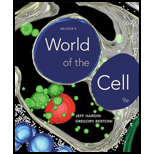
(a)
To determine: The concentration gradient of protons across the epithelial membrane.
Introduction: The transport of sodium and potassium ions across the membrane is an active transport process, which involves the hydrolysis of adenosine triphosphate (ATP) to provide energy. The gastric juice in the human stomach has a pH of 2.0. This acidity is due to the secretion of protons into the stomach by the epithelial cells of the gastric mucosa.
(b)
To determine: The free energy change associated with the secretion of 1 mole of protons into gastric juice at 37°C.
Introduction: The transport of sodium and potassium ions across the membrane is an active transport process, which involves the hydrolysis of adenosine triphosphate (ATP) to provide energy. The gastric juice in the human stomach has a pH of 2.0. This acidity is due to the secretion of protons into the stomach by the epithelial cells of the gastric mucosa.
(c)
To determine: If proton transport can be driven by ATP hydrolysis at the ratio of one molecule of ATP per protein transported.
Introduction: The transport of sodium and potassium ions across the membrane is an active transport process, which involves the hydrolysis of adenosine triphosphate (ATP) to provide energy. The gastric juice in the human stomach has a pH of 2.0. This acidity is due to the secretion of protons into the stomach by the epithelial cells of the gastric mucosa.
(d)
To determine: The membrane potential that would be required to prevent proton to move back into the cell.
Introduction: The transport of sodium and potassium ions across the membrane is an active transport process, which involves the hydrolysis of adenosine triphosphate (ATP) to provide energy. The gastric juice in the human stomach has a pH of 2.0. This acidity is due to the secretion of protons into the stomach by the epithelial cells of the gastric mucosa.
Want to see the full answer?
Check out a sample textbook solution
Chapter 8 Solutions
Becker's World of the Cell (9th Edition)
- students in a science class investiged the conditions under which corn seeds would germinate most successfully. BAsed on the results which of these factors appears most important for successful corn seed germination.arrow_forwardI want to write the given physician orders in the kardex formarrow_forwardAmino Acid Coclow TABle 3' Gly Phe Leu (G) (F) (L) 3- Val (V) Arg (R) Ser (S) Ala (A) Lys (K) CAG G Glu Asp (E) (D) Ser (S) CCCAGUCAGUCAGUCAG 0204 C U A G C Asn (N) G 4 A AGU C GU (5) AC C UGA A G5 C CUGACUGACUGACUGAC Thr (T) Met (M) lle £€ (1) U 4 G Tyr Σε (Y) U Cys (C) C A G Trp (W) 3' U C A Leu בוט His Pro (P) ££ (H) Gin (Q) Arg 흐름 (R) (L) Start Stop 8. Transcription and Translation Practice: (Video 10-1 and 10-2) A. Below is the sense strand of a DNA gene. Using the sense strand, create the antisense DNA strand and label the 5' and 3' ends. B. Use the antisense strand that you create in part A as a template to create the mRNA transcript of the gene and label the 5' and 3' ends. C. Translate the mRNA you produced in part B into the polypeptide sequence making sure to follow all the rules of translation. 5'-AGCATGACTAATAGTTGTTGAGCTGTC-3' (sense strand) 4arrow_forward
- What is the structure and function of Eukaryotic cells, including their organelles? How are Eukaryotic cells different than Prokaryotic cells, in terms of evolution which form of the cell might have came first? How do Eukaryotic cells become malignant (cancerous)?arrow_forwardWhat are the roles of DNA and proteins inside of the cell? What are the building blocks or molecular components of the DNA and proteins? How are proteins produced within the cell? What connection is there between DNA, proteins, and the cell cycle? What is the relationship between DNA, proteins, and Cancer?arrow_forwardWhy cells go through various types of cell division and how eukaryotic cells control cell growth through the cell cycle control system?arrow_forward
 Biology: The Dynamic Science (MindTap Course List)BiologyISBN:9781305389892Author:Peter J. Russell, Paul E. Hertz, Beverly McMillanPublisher:Cengage Learning
Biology: The Dynamic Science (MindTap Course List)BiologyISBN:9781305389892Author:Peter J. Russell, Paul E. Hertz, Beverly McMillanPublisher:Cengage Learning Biology 2eBiologyISBN:9781947172517Author:Matthew Douglas, Jung Choi, Mary Ann ClarkPublisher:OpenStax
Biology 2eBiologyISBN:9781947172517Author:Matthew Douglas, Jung Choi, Mary Ann ClarkPublisher:OpenStax Biology (MindTap Course List)BiologyISBN:9781337392938Author:Eldra Solomon, Charles Martin, Diana W. Martin, Linda R. BergPublisher:Cengage Learning
Biology (MindTap Course List)BiologyISBN:9781337392938Author:Eldra Solomon, Charles Martin, Diana W. Martin, Linda R. BergPublisher:Cengage Learning BiochemistryBiochemistryISBN:9781305577206Author:Reginald H. Garrett, Charles M. GrishamPublisher:Cengage Learning
BiochemistryBiochemistryISBN:9781305577206Author:Reginald H. Garrett, Charles M. GrishamPublisher:Cengage Learning





